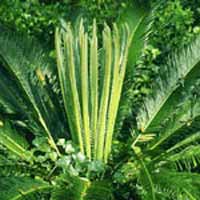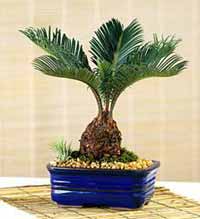 I just received a new edition of my ASPCA newsletter and one article in particular caught my eye. It was about the increased incidence of pets being poisoned by the Sago Palm. This plant can also be quite toxic to young children.
I just received a new edition of my ASPCA newsletter and one article in particular caught my eye. It was about the increased incidence of pets being poisoned by the Sago Palm. This plant can also be quite toxic to young children.
The Sago Palm is common in warm climates, but it’s become more popular in Northern homes as a houseplant. The plant is native to Southern Japan. It’s an attractive plant with dark green leaves and a hairy trunk.
Since 2003, the ASPCA Animal Poison Control Center has seen an increase in cases of Sago palm and Cycad poisonings by more than 200 percent. APCC data also reveals that 50 percent to 75 percent of those cases resulted in fatalities.
 A chemical in the plant called cycasin is toxic and often causes permanent liver damage as well as neurological damage if enough of the poison is absorbed by the body. The seeds are the most poisonous part of the plant, although all parts of this plant are toxic, and the effects on humans are seizures, coma and death. Of course the seeds are an attractive reddish color so children and possible curious pets might be drawn to the plant.
A chemical in the plant called cycasin is toxic and often causes permanent liver damage as well as neurological damage if enough of the poison is absorbed by the body. The seeds are the most poisonous part of the plant, although all parts of this plant are toxic, and the effects on humans are seizures, coma and death. Of course the seeds are an attractive reddish color so children and possible curious pets might be drawn to the plant.
Clinical signs of toxic poisoning are vomiting, melena (blood in stool), Jaundice, increased thirst, hemorrhagic gastroenteritis, bruising and later liver damage, liver failure and death.
If you have young children or pets in your home and you’d like to check to see if your house or garden plants are toxic you can take a look at this list of Toxic Plants. There’s also a list of non-toxic plants that you might also want to look at if you are planning on adding more plants to your collection.
The Holly plant is also very toxic. I have a few bushes in front of my porch and just about had a heart attack when I caught a neighbor kid picking the berries to eat.
Huh, this is good to know. Every homeowner these days seems to be crazy about these palms, and they get excited when they hear there’s a sale on them. I wonder if this poison issue will change their minds.
I wasn’t aware of this. Thank you for sharing. I used to have a sago palm in my apartment where I didn’t have my cats. The palm ended up dying as my roommate relocated it to a high shelf in the pantry where he forgot about it and I didn’t see it. They are very pretty plants and it’s a shame they’re poisonous. I now have cats and won’t be decorating my house with this plant.
Thank you also, for sharing the list of other poisonous plants. I will take a look and keep them in mind when I go plant shopping to decorate my new home.
It’s unfortunate to know something so beautiful to look at can be poisonous. Thanks for informing the world about this dangerous plant.
I didn’t know this, thanks for the advice. I had one of these in my house and I have three dogs.
not only sago plants, there are thousands of of plants which are toxic to both humans and animals as well . Gloriosa, manioc, adenia are some of them.
But this article provide a good account on saga plant which is very interesting.
thanks for info
i will surely share that info with friends
Unfortunately our pets will naturally chew or consume things they shouldn’t. Its been known pets have eaten toys, jewelry, and toxic items including plants or rat poisons, but there are safe pest control products out there. Us as pet owners we have to make sure our homes and yards are safe for our pets look around the house and yard and be aware of what your pet might get into. Also learn the plants that are in your yard, if you have berries growing on a bush that are poisonous, remove them if you have not only pets but children may think they are just some fruit.
Specifically with reference to the Sago palm, this is one of the oldest (if not the oldest) plant species known. Perhaps it is this toxicity that has enabled it to survive. Just hope we don’t wipe it out with careless or unmanaged invasion of the natural habitats within which these plants are found.
Yup it is one of the plants with adverse effects on both humans and pets. Usually they leave their toxic affects on you upon ingestion but the toxin can also seep through your skin while handling seeds to grow new plants from seeds. So one should always wear gardening gloves while gardening.